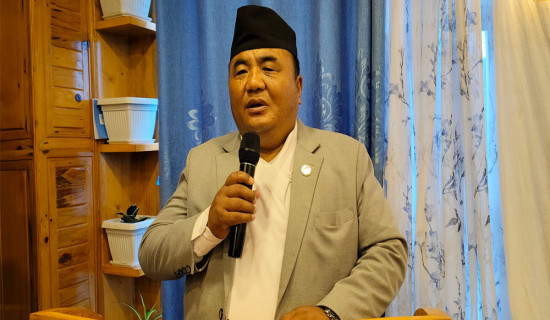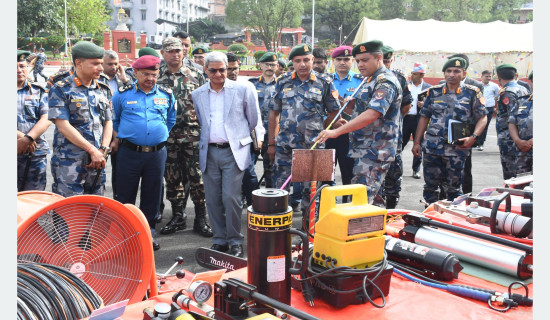- Tuesday, 3 June 2025
Manmade activities putting wetlands at risk
By Aashish Mishra/Abinash Chaudhary,Lalitpur/Dhangadhi, Feb. 3: Wetlands provide habitat for a wide range of flora and fauna, improve water quality, recharge groundwater, act as carbon sinks and provide opportunities for recreational activities. And when situated in and around urban areas, they also become part of the community’s culture and provide its residents an opportunity to connect with nature.
Nagdaha, in Dhapakhel, Lalitpur Metropolitan City–24, Lalitpur, is one such wetland. However, it is at risk, expressed speakers at a programme organised at the lake on Thursday on the occasion of World Wetlands Day.
Members of the group Wetlands for Nepal (WfN) and the local Nagdaha United Club (NUC) worried that concretisation of the shores, accumulation of sediment and growth of water hyacinth threatened the existence of Nagdaha.
This requires urgent attention from the local government and stakeholders, the two groups which organised Thursday’s event in collaboration with organisations Sustainability and Environmental Studies Endeavor (SENSE), Nature Conservation and Research Hub (NCRH) and The Small Earth Nepal (SEN), stressed.
Without attention, Nagdaha may meet a fate similar to the Purina Lake.
The lake was a large body of water that was a haven of tranquillity in Himmatpur, Bhajani Municipality–7 up until a decade ago. The lake had an area of 150 hectares and was home for birds like the Sarus Crane. But encroachment that sped up from 2010 has now turned this entire lake into farmland.
Rakhouna Lake, the large wetland in the Basanta forest in Baijpur, Kailari Rural Municipality–5, is also fast deteriorating. Contractors who use the lake’s water to farm fish drain it completely empty in the winter.
In fact, nearly every single wetland present in Kailali district is under threat due to human activities like encroachment and over-exploitation, said conservationist and president of the Dolphin, Aquatic and Biodiversity Society of Nepal Bhojraj Dhungana. “This may be the cause of severe problems for us in the future,” he warned.
According to the United States of America’s Environmental Protection Agency, wetlands are areas where water covers the soil, or is present either at or near the surface of the soil all year or for varying periods of time during the year, including during the growing season. Simply put, they are muddy or swampy areas with a significant presence of water that play a vital part in storing and sustaining water and life.
However, it is worrying to see areas of such importance get drained and/or transformed for various purposes, said Gokul Prasad Rijal, chief of the Division Forest Office of Pahalmanpur. “Although Kailali has the largest number of wetlands in Terai for now, they are disappearing,” he noted, adding, “The wetlands in Chure, Ghodaghodi and Basanta areas are being heavily encroached upon.”
The condition of Hanryahan Lake, which occupies 20 to 25 hectares of land in Basanta Corridor, and Pasryahan Lake, spread over an area of eight to 10 bighas, should cause concern, as should the commercial fish farming that is impacting the natural state of Koilahi, Chamrahiya, Banjaria, Piparhuwa, Laukaha-Bhaukaha, Soniyan-Rupiyan and Ojuwa lakes.
Fish farming contractors, in particular, show little regard for the wetlands’ health and haphazardly dry out the lakes for their convenience.
“It is not wrong to utilise natural water bodies for income but our livelihood should not bring destruction for both the water sources and the birds and animals that depend on them. “We have to be careful of this even while carrying out preservation activities,” Rijal said, hinting at the use of concrete that separate the wet (water) from the land (soil) and disrupt the water recharge cycle.
Meanwhile, to prevent the Nagdaha (Daha means pond or lake) from becoming the Nag-field or Nag-ground, WfN, NUC and SEN have been carrying out various activities including regular cleaning and the testing of a Floating Treatment Wetland System for pollution-removal. WfN also informed at the event that they plan to build a sediment retention pond at a designated plot of land to prevent the inflow of debris that may shrink the water body.
WfN and NUC are also proto-typing the production of biopesticide from the invasive plants that risk covering Nagdaha that will both manage the water hyacinths and curb the use of chemical pesticides in nearby fields.
Wetlands are considered to be the world of aquatic life. However, the problem in the wetland itself is affecting the ecological system. During the dry season, there is a problem that the stream dries up or there is less water in some areas. So the number of water birds that feed and breed in the water also decreases.
















